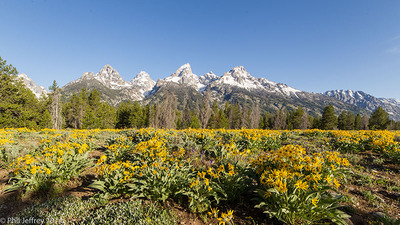
Sunflowers at Teton Glacier overlook, Grand Teton National Park, WY
This trip was the conceptual combination of three prior trips: the Big Flycatcher trip of 2006 that started in Phoenix and ended at Denver; the Salt Lake City trip of July 2007; the MN-ND-WY trip of June 2009 whose western apex was Grand Teton. Designed mainly as western montane trip featuring my second trip to the Grand Teton NP as its centerpiece, and the adjacent Yellowstone NP. I added some lowland/water birds around Salt Lake and in Idaho, and a little plains birding in Colorado but overall trip diversity was limited by the western montane habitat emphasis. Although I could have arranged an SLC-WY-and-done trip my recent penchant for multi-leg trips led me to break the return in Denver where I did some birding around Rocky Mountain National Park and as far west as Ouray, while adding a few plains birds around Pawnee NG.

Sunflowers at Teton Glacier overlook, Grand Teton National Park, WY
As ever trip planning was led by local bird lists, the ABA/Lane and Falcon guides I have for these states, and my prior experience birding those areas (see the above trip reports). The latter was invaluable for a sense of scale and terrain. Cornell's EBird project was used for both recent sightings via their own web interface and my data mining approach (see: yblb) and the new ebird hotspot search facility allowed me to find potential en route destinations to pad both the trip and state lists. I did not find the BirdsEye app that much use on this trip because it was malfunctioning. The app can be very flaky and so reliance on it is not a good idea. It probably cost me a few trip birds by not being able to survey local reports on-the-fly.
| SLC | Sunrise 6:00 am | Sunset 9:00 pm |
| Denver | Sunrise 5:30 am | Sunset 8:30 pm |
| UTAH birders | http://birding.aba.org/maillist/UT01 | |
| UTAH rare birds | http://birding.aba.org/maillist/UT02 | |
| UTAH BirdTalk | http://birding.aba.org/maillist/UT03 | |
| UBird | http://www.utahbirders.com/ubird#tab-2 | https://groups.google.com/forum/#!forum/ubird |
| IDAHO list | http://birding.aba.org/maillist/ID01 | |
| MONTANA list | http://birding.aba.org/maillist/MT | |
| WYOMING list | http://birding.aba.org/maillist/WY | |
| COLORADO list | http://birding.aba.org/maillist/CO01 | https://groups.google.com/forum/#!forum/cobirds |
| COLORADO list | https://groups.yahoo.com/neo/groups/cobirders/conversations/messages |
| COBUS | http://coloradobirdingsociety.net16.net/ |
| COBUS/county | http://coloradobirdingsociety.net16.net/countymap.htm |
| CFO/county | http://coloradocountybirding.org/ |
| CFO specialities | http://coloradocountybirding.org/Specialties.aspx |
| Utah Birders | http://www.utahbirders.com/ |
| Utah Hotspots A-Z | http://utahbirdingspots.blogspot.com/2014/03/birding-locations-z-alphabetical.html |
| Utah Hotspots/County | http://utahbirdingspots.blogspot.com/2014/03/birding-locations-by-county.html |
| Utah Birding Hotline | http://www.utahbirds.org/HotlineReports.htm |
| My Year Bird-Life Bird web project | http://www.philjeffrey.net/yblb/yblb_py.cgi |
| My trip report for CO-AZ-NM 2006 | http://philjeffrey.net/AZ_NM_CO2.html |
| My trip report for SLC 2007 | http://www.philjeffrey.net/SLC2007.html |
| My trip report for MN-ND-SD-MT-WY from 2009 | http://www.philjeffrey.net/MN-ND-WY2.html |
I largely know where I'm going in Colorado so I didn't survey trip reports for there - just sightings data (see above).
| Pied-billed Grebe | Podilymbus podiceps | ID, CO | |
| Red-necked Grebe | Podiceps grisegena | ID | Henry's Lake |
| Eared Grebe | Podiceps nigricollis | ID, UT, CO | |
| Western Grebe | Aechmophorus occidentalis | WY, ID, UT, CO | |
| Clark's Grebe | Aechmophorus clarkii | UT, CO | |
| American White Pelican | Pelecanus erythrorhynchos | WY, ID, CO | |
| Double-crested Cormorant | Phalacrocorax auritus | ID, UT, CO | |
| Great Blue Heron | Ardea herodias | WY, ?CO | |
| Snowy Egret | Egretta thula | ID, CO | |
| Black-crowned Night-Heron | Nycticorax nycticorax | ID, CO | |
| White-faced Ibis | Plegadis chihi | ID, UT, CO | common in lowland UT, ID |
| Turkey Vulture | Cathartes aura | UT, WY, ID, CO | low #s but widespread |
| Canada Goose | Branta canadensis | WY, ID, CO | |
| Trumpeter Swan | Cygnus buccinator | WY | Grand Teton NP/Jackson only |
| Gadwall | Anas strepera | WY, ID, CO | |
| American Wigeon | Anas americana | WY, CO | |
| Mallard | Anas platyrhynchos | UT, WY, ID, CO | |
| Blue-winged Teal | Anas discors | CO | |
| Cinnamon Teal | Anas cyanoptera | UT, WY, CO | common in UT, less so elsewhere |
| Northern Shoveler | Anas clypeata | ID | |
| Green-winged Teal | Anas crecca | WY, UT | uncommon |
| Canvasback | Aythya valisineria | CO | Walden/Lake John |
| Redhead | Aythya americana | WY, ID | widespread |
| Ring-necked Duck | Aythya collaris | ID, CO | uncommon |
| Lesser Scaup | Aythya affinis | WY, ID, CO | widespread |
| Harlequin Duck | Histrionicus histrionicus | WY | Yellowstone NP |
| Bufflehead | Bucephala albeola | ID | Henry's Lake |
| Barrow's Goldeneye | Bucephala islandica | WY | Yellowstone NP |
| Common Merganser | Mergus merganser | WY | Yellowstone NP |
| Ruddy Duck | Oxyura jamaicensis | WY, UT, ID, CO | |
| Osprey | Pandion haliaetus | WY, CO | uncommon |
| Bald Eagle | Haliaeetus leucocephalus | WY, ?ID | one or two only |
| Northern Harrier | Circus cyaneus | WY, UT, ID | |
| Cooper's Hawk | Accipiter cooperii | CO | |
| Swainson's Hawk | Buteo swainsoni | UT, WY, CO | |
| Red-tailed Hawk | Buteo jamaicensis | UT, WY, ID, CO | |
| Golden Eagle | Aquila chrysaetos | UT, CO | |
| American Kestrel | Falco sparverius | UT, WY, ID, CO | |
| Prairie Falcon | Falco mexicanus | CO | near Rifle |
| White-tailed Ptarmigan | Lagopus leucurus | CO | Rocky Mountain NP |
| Dusky Grouse | Dendragapus obscurus | WY | Grand Teton NP |
| Gambel's Quail | Callipepla gambelii | CO | Colorado NM |
| Sora | Porzana carolina | (WY), (ID) | |
| American Coot | Fulica americana | WY, UT, ID, CO | |
| Sandhill Crane | Antigone canadensis | WY, UT | |
| Killdeer | Charadrius vociferus | WY, ID, CO | |
| Black-necked Stilt | Himantopus mexicanus | UT | |
| American Avocet | Recurvirostra americana | UT, CO | |
| Willet | Catoptrophorus semipalmatus | UT, CO | |
| Spotted Sandpiper | Actitis macularia | WY, CO | |
| Long-billed Curlew | Numenius americanus | UT | |
| Wilson's Phalarope | Phalaropus tricolor | UT, CO | Salt Lake, Walden/Lake John |
| Franklin's Gull | Leucophaeus pipixcan | UT, ID | |
| Ring-billed Gull | Larus delawarensis | ID | |
| California Gull | Larus californicus | UT, ?WY, ID, CO | |
| Caspian Tern | Sterna caspia | UT, ID | |
| Forster's Tern | Sterna forsteri | UT, ID, CO | |
| Rock Pigeon | Columba livia | UT, ID, WY, CO | |
| Eurasian Collared-Dove | Streptopelia decaocto | UT, WY, ID, CO | |
| Mourning Dove | Zenaida macroura | UT, WY, CO | |
| Great Horned Owl | Bubo virginianus | UT | |
| Burrowing Owl | Athene cunicularia | CO | |
| Short-eared Owl | Asio flammeus | ID | |
| Common Nighthawk | Chordeiles minor | ?WY, ID, CO | |
| Black Swift | Cypseloides niger | CO | Ouray |
| White-throated Swift | Aeronautes saxatalis | WY, CO | |
| Black-chinned Hummingbird | Archilochus alexandri | CO | Colorado NM |
| Calliope Hummingbird | Selasphorus calliope | WY | |
| Broad-tailed Hummingbird | Selasphorus platycercus | UT, (WY), CO | |
| Belted Kingfisher | Megaceryle alcyon | WY, CO | |
| Lewis's Woodpecker | Melanerpes lewis | CO | |
| Williamson's Sapsucker | Sphyrapicus thyroideus | WY | |
| Red-naped Sapsucker | Sphyrapicus nuchalis | WY, CO | |
| Downy Woodpecker | Picoides pubescens | WY | |
| Hairy Woodpecker | Picoides villosus | UT, WY, CO | |
| Northern Flicker | Colaptes auratus | UT, WY, ID, CO | |
| Olive-sided Flycatcher | Contopus cooperi | WY, CO | |
| Western Wood-Pewee | Contopus sordidulus | UT, WY, CO | |
| Willow Flycatcher | Empidonax traillii | UT, (CO) | |
| Hammond's Flycatcher | Empidonax hammondii | WY | Grand Teton NP |
| Dusky Flycatcher | Empidonax oberholseri | WY, CO | |
| Cordilleran Flycatcher | Empidonax occidentalis | CO | Rocky Mountain NP, Reynolds Park |
| Ash-throated Flycatcher | Myiarchus cinerascens | CO | Colorado NM |
| Western Kingbird | Tyrannus verticalis | ID, UT, CO | |
| Eastern Kingbird | Tyrannus tyrannus | ID, UT, CO | |
| Loggerhead Shrike | Lanius ludovicianus | UT, CO | very uncommon |
| Gray Vireo | Vireo vicinior | CO | Coal Canyon, ?Colorado NM |
| Plumbeous Vireo | Vireo plumbeus | CO | Colorado NM |
| Warbling Vireo | Vireo gilvus | UT, WY, ID, CO | |
| Gray Jay | Perisoreus canadensis | WY | Grand Teton NP |
| Steller's Jay | Cyanocitta stelleri | CO | Conifer |
| Blue Jay | Cyanocitta cristata | CO | Front Range foothills |
| Western (Woodhouse's) Scrub-Jay | Aphelocoma californica | CO | Colorado NM |
| Clark's Nutcracker | Nucifraga columbiana | UT, WY, CO | |
| Black-billed Magpie | Pica hudsonia | UT, WY, ID, CO | |
| American Crow | Corvus brachyrhynchos | WY, CO | |
| Common Raven | Corvus corax | UT, WY, CO | |
| Horned Lark | Eremophila alpestris | UT, WY, MT, CO | |
| Tree Swallow | Tachycineta bicolor | WY, CO | |
| Violet-green Swallow | Tachycineta thalassina | UT, WY, CO | |
| Northern Rough-winged Swallow | Stelgidopteryx serripennis | WY, ID, CO | uncommon at best |
| Bank Swallow | Riparia riparia | ID | Henry's Lake |
| Cliff Swallow | Petrochelidon pyrrhonota | UT, WY, CO | locally abundant |
| Barn Swallow | Hirundo rustica | UT, WY, CO | common |
| Black-capped Chickadee | Poecile atricapilla | WY, (CO) | |
| Mountain Chickadee | Poecile gambeli | UT, WY, CO | |
| Juniper Titmouse | Baeolophus griseus | CO | Colorado NM |
| Bushtit | Psaltriparus minimus | CO | Colorado NM |
| Red-breasted Nuthatch | Sitta canadensis | UT, WY, ?CO | |
| White-breasted Nuthatch | Sitta carolinensis | (CO) | |
| Brown Creeper | Certhia americana | UT | |
| Rock Wren | Salpinctes obsoletus | CO | Colorado NM |
| Canyon Wren | Catherpes mexicanus | (CO) | Colorado NM |
| House Wren | Troglodytes aedon | WY, (UT), CO | |
| Marsh Wren | Cistothorus palustris | UT, (ID) | |
| American Dipper | Cinclus mexicanus | WY | |
| Ruby-crowned Kinglet | Regulus calendula | UT, WY, CO | |
| Blue-gray Gnatcatcher | Polioptila caerulea | CO | |
| Mountain Bluebird | Sialia currucoides | UT, WY, CO | Downright common at times |
| Townsend's Solitaire | Myadestes townsendi | UT, WY, CO | |
| Swainson's Thrush | Catharus ustulatus | UT, WY | |
| Hermit Thrush | Catharus guttatus | (UT),(WY),(CO) | |
| American Robin | Turdus migratorius | UT, WY, ID, CO | |
| Gray Catbird | Dumetella carolinensis | WY | Grand Teton NP |
| Sage Thrasher | Oreoscoptes montanus | CO | |
| European Starling | Sturnus vulgaris | UT, WY, CO | |
| American Pipit | Anthus rubescens | MT, WY, CO | |
| Cedar Waxwing | Bombycilla cedrorum | WY, UT | |
| Orange-crowned Warbler | Oreothlypis celata | UT | |
| Virginia's Warbler | Oreothlypis virginiae | CO | |
| MacGillivray's Warbler | Geothlypis tolmiei | UT, WY | |
| Common Yellowthroat | Geothlypis trichas | (ID), (CO) | |
| Yellow Warbler | Setophaga petechia | UT, WY, CO | widespread |
| Yellow-rumped Warbler | Setophaga coronata | UT, WY, CO | widespread |
| Wilson's Warbler | Cardellina pusilla | CO | Rocky Mountain NP |
| Western Tanager | Piranga ludoviciana | (UT), WY, CO | |
| Green-tailed Towhee | Pipilo chlorurus | UT, WY, CO | |
| Spotted Towhee | Pipilo maculatus | UT, (WY), CO | |
| Cassin's Sparrow | Peucaea cassinii | CO | Pawnee NG |
| Chipping Sparrow | Spizella passerina | WY, CO | |
| Brewer's Sparrow | Spizella breweri | WY, ID, CO | Most heard/seen in Grand Teton NP |
| Vesper Sparrow | Pooecetes gramineus | ID, WY, CO | Often numerous in sagebrush |
| Lark Sparrow | Chondestes grammacus | CO | Pawnee NG and Colorado NM |
| Black-throated Sparrow | Amphispiza bilineata | CO | Coal Canyon and Colorado NM |
| Lark Bunting | Calamospiza melanocorys | CO | |
| Savannah Sparrow | Passerculus sandwichensis | ID, UT, CO | |
| Grasshopper Sparrow | Ammodramus savannarum | CO | Pawnee NG |
| Fox Sparrow | Passerella iliaca | UT | |
| Song Sparrow | Melospiza melodia | UT, (WY), CO | |
| Lincoln's Sparrow | Melospiza lincolnii | UT, WY, CO | |
| White-crowned Sparrow | Zonotrichia leucophrys | UT, WY, CO | |
| Dark-eyed Junco | Junco hyemalis | UT, WY, CO | |
| McCown's Longspur | Rhynchophanes mccownii | CO | Pawnee NG |
| Black-headed Grosbeak | Pheucticus melanocephalus | UT, WY | Singles, 2 locations |
| Lazuli Bunting | Passerina amoena | UT, WY | |
| Red-winged Blackbird | Agelaius phoeniceus | UT, WY, CO | |
| Western Meadowlark | Sturnella neglecta | UT, WY, CO | |
| Yellow-headed Blackbird | Xanthocephalus xanthocephalus | UT, WY, ID, CO | |
| Brewer's Blackbird | Euphagus cyanocephalus | UT, WY, ID, CO | |
| Common Grackle | Quiscalus quiscula | WY, CO | |
| Great-tailed Grackle | Quiscalus mexicanus | UT | |
| Brown-headed Cowbird | Molothrus ater | WY, CO | |
| Bullock's Oriole | Icterus bullockii | CO, ?ID | |
| Black Rosy-Finch | Leucosticte atrata | WY, MT | |
| Pine Grosbeak | Pinicola enucleator | CO | Rocky Mtn NP |
| Cassin's Finch | Haemorhous cassinii | UT, WY, ID | |
| House Finch | Haemorhous mexicanus | UT, CO | |
| Red Crossbill | Loxia curvirostra | UT, CO | |
| Pine Siskin | Carduelis pinus | UT, WY, CO | |
| Lesser Goldfinch | Carduelis psaltria | CO | Colorado NM |
| American Goldfinch | Carduelis tristis | UT, CO | |
| House Sparrow | Passer domesticus | UT, WY, CO |
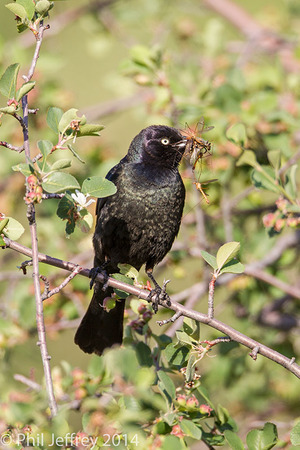
Male Brewer's Blackbird with food, Wasatch Mtns, Utah
(clicking on images usually brings up larger versions)
(All photos and text herein are copyright © Phil Jeffrey 2014)
At the bottom of the pass in the sagebrush near Jeremy Ranch Road: Yellow Warbler, Brewer's Blackbird, flycatcher sp (Western Kingbird-ish), Northern Flicker, Barn Swallow, Song Sparrow. Along Jeremy Ranch Road itself, from it's northern end, this turned out to be a dirt road with "No Trespassing" signs on both sides that lured me deeper along the road with a lot of bird song - mainly Yellow Warbler, and then a distant Green-tailed Towhee and Willow Flycatcher, MacGillivray's Warbler, several Mule Deer. The Willow Flycatcher was a nice surprise and the MacGillivray's gave decent looks for an oft-skulking bird.
Returning back to the top of Big Mountain pass along SR-65, Violet-green Swallows on the wires, Lazuli Bunting, MacGillivray's Warbler, (Dusky-ish Empidonax flycatcher), (Orange-crowned Warbler), (Warbling Vireo), (Swainson's Thrush). Already farcically behind schedule on my first location of the day I didn't invest the extra time in attempting to track down these heard-only species. I skipped Little Dell Reservoir (potential water birds, locally rare Least Flycatcher) although I did pick up Cliff Swallows nesting under road bridges as I got back to I-80. Besides icterids, swallows were the other dirt bird of the trip, mainly Cliff and Barn with some Tree and Violet-green. Returning toward Salt Lake City on I-80 I cut south on I-215 and got the oddest sighting of a Black-headed Grosbeak over the interstate - pretty unambiguous in flight and seen well. I culled a few optional sites and headed up Big Cottonwood Canyon towards Brighton.
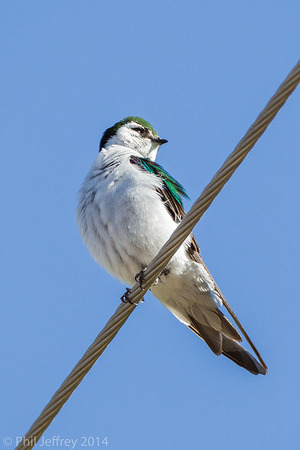
Adult Violet-green Swallow, Wasatch Mtns, Utah
At Brighton the store was closed, so no stopping for snacks and instead on to Silver Lake where I circumnavigated the lake: Mallard, Spotted Sandpiper, White-crowned Sparrow, Lincoln's Sparrow with its especially demonstrative song sounding towhee-like (this bird always sounds "bigger" to me than it really is), Violet-green Swallow nest-building at the visitor center (closed also), Pine Siskins, a single male Red Crossbill, Ruby-crowned Kinglet, Western Wood-Pewee, (MacGillivray's Warbler), Mountain Chickadee, (Hammond-ish Empidonax flycatcher), Brewer's Blackbird. Silver Lake is at altitude and there were some snow patches remaining in the shady forested parts. A Broad-tailed Hummingbird zipped by with it's characteristic tail feather trill.
Since my ultimate goal was Mirror Lake highway it made most sense to traverse Guardsman's Pass down towards Heber via a side road just below the loop road around Brighton. Quite good road surface for most of the way - seems like they've made some paving effort in recent years. Down the pass there was quite a lot of promising habitat but not a lot seen while traversing it. At one stop: Mountain Bluebird, Green-tailed Towhee, MacGillivray's Warbler, Broad-tailed Hummingbird. This would be a very promising valley to explore further when I had more time, since traffic is generally light, and there has to be Ruffed Grouse in the mixed forest areas.
Down the in valley near Heber: Black-billed Magpie, Eastern Collared-Dove, Mourning Dove, an Osprey nest along River Road. and in the grasslands north of Heber: Red-winged Blackbird, Brewer's Blackbird, Western Meadowlark, Sandhill Crane, Northern Flicker, American Robin but no Bobolinks which were the specific bird that caused me to make this stop. A few farms in this grassy river valley were up for sale, making one wonder how long this habitat is going to last.
Grabbing a late breakfast in Heber I wasted no time heading to the Mirror Lake scenic highway (SR-150) up into the Uinta Mountains, not finding all that much in transit but stopping only infrequently because of time constraints. At the top of the pass there was still a fair amount of soft snow that limited progress so I found only Pine Siskin, probable Cassin's Finch, American Robin, and a distant Towsend's Solitaire. White-crowned Sparrow was heard west of the summit in the alpine meadows but despite the existing snow the temperature at the top of the pass was a balmy 58 degrees. Black Rosy-Finches were not to be found - I had one here in July 2007.
At Mirror Lake itself there was more melting surface snow with some local bird activity: more Pine Siskins, Dark-eyed Junco singing, Audubon's Yellow-rumped Warbler, Cassin's Finch, Clark's Nutcracker. I took the trail looking for Three-toed Woodpecker (alas, no) but found: Pine Siskins, Yellow-rumped Warbler, Clark's Nutcracker, a female Hairy Woodpecker, Chipping Sparrow and Brown Creeper. More extensive searching at Mirror Lake for Three-toed had to be curtailed in light of being well behind schedule.
Instead I descended out of the Uintas into a broadening sagebrush valley, still along SR-150 - my last bird in UT: American Kestrel in the flats. My first birds in WY: Mountain Bluebird and Sandhill Crane. In Wyoming more sagebrush had been cleared into ranch land, perhaps marking the exit from the Uinta-Wasatch-Cache NF. I was going to be following much of the headwaters of the Bear River while in Wyoming. A few individual Turkey Vultures and icterids showed up roadside. I went north through Evanston, switching from SR-150 to SR-89, seeing likely California Gulls in the air, and a Black-billed Magpie. I skipped the Woodruff Narrows Reservoir site (potential water birds) because of time pressure. Re-entering Utah (WY/SR-89 became UT/SR-16) I realized I was in territory I encountered during the 2007 SLC trip, but here I stayed northbound on SR-16 rather than taking SR-39. Deseret Ranch - a good birding location - is in this area but access is controlled by a few birders who hold the birding access rights to the ranch and charge for access. I did find Yellow-headed Blackbird in the roadside marshes in this area. The marshland here along SR-16 probably warrants some more leisurely birding although the road does not really offer safe pull-offs. A single Golden Eagle was seen perched along SR-16, my first for Utah.
Where SR-16 met SR-30 I encountered a strange field full of Swainson's Hawks and a Golden Eagle, several Common Ravens. The Swainson's might have been attracted by field irrigation and were in a confusing variety of plumages that seemed predominantly immature birds. This sort of concentration of them during the breeding season seemed unusual. Yellow-headed Blackbirds were amongst other blackbirds in the wet area along SR-30, still in Utah. Back into WY with UT/SR-30 turning into WY/SR-30 the habitat became sagebrush again. North on US-30 towards Cokeville I had a dark morph Swainson's Hawk, then a pull-out at Cokeville Meadows NWR had no obvious tour route but Yellow-headed Blackbird, Red-winged Blackbird and Brewer's Blackbird with another Turkey Vulture.
I left US-30 to travel along the WY-ID border using WY/SR-89 and then dipped into Idaho for a few miles: American Robin, Turkey Vulture, Black-billed Magpie, Brewer's Blackbird were the first four birds of my Idaho state list before I went back into Wyoming onto US-89. At that point I left the Bear River drainage (water headed towards the Great Salt Lake) and headed towards the Salt River in the headwaters of the Snake River. Rather than traverse passes, the WY roads north toward Jackson favor following river valleys where I sometimes encounted willow-filled montane valleys with beaver dams - surely good Calliope Hummingbird habitat here. Afton, WY didn't have much to recommend it but had the novelty of a road-spanning Elk antler arch. I stopped at at Wyoming Division of Wildlife display just south of Alpine Junction. Here at my first encounter with the Snake River I had Great Blue Heron, Yellow-headed Blackbird, Red-winged Blackbird, Brewer's Blackbird, Mallard, Yellow Warbler, distant American Pelicans, Osprey at nest right next to the pullout but no map for water bird access. Probably the unsigned dirt roads I saw through the fences would have worked, but instead I cut back into Idaho up the north shore of Palisades Reservoir via US-26 and added to my Idaho list: American White Pelican, Great Blue Heron, Double-crested Cormorant, grebe sp, California-ish Gulls, Common Raven, American Crow. American Crows were also increasingly in evidence as I followed the Snake River upstream back into WY as I approached Jackson along US-26. Being on the west side of the Continental Divide, the Snake River flows ultimately into the Columbia River and the Pacific.
I checked in at the Snow King motel which had fairly small rooms but were comfortable, coffee and fridge in the room, free WiFi, and being the cheapest in Jackson that I could find on the web. Recommended unless you want a Sheraton-like experience, which this certainly was not, but it had more than enough to satisfy me. Prices for the inferior Motel 6 were considerably higher than this place, and the Motel 6 prices had taken a large jump since my 2009 trip. At the flats overlook on the north side of Jackson: Mallard, Gadwall, Yellow-headed Blackbird, Brewer's Blackbird, Canada Goose, a single Trumpeter Swan, Barn Swallow, Northern Harrier nearby. A Belted Kingfisher flew over the road along the Snake River on my trek to Oxbow Bend where I found American White Pelican, Black-billed Magpies, Cliff Swallows and at the summit of a nearby mountain two Dusky Grouse, one of which was displaying. Dusky Grouse was a decent trade-off for the sites I had skipped and short-changed the rest of the day, and I only just got there before dusk.
It was already sunset so birding ended pretty quickly in Grand Teton NP and I returned toward Jackson via the more meandering park road where I thought I saw a Common Nighthawk hunting low over road - not sure if you could eliminate Common Poorwill in this instance. Made for a long day of driving, with multiple sites triaged from the itinerary.
Year Birds: Red-breasted Nuthatch, Trumpeter Swan, Dusky Grouse, MacGillivray's Warbler, Red Crossbill, Hairy Woodpecker, Western Wood-Pewee
Overnight: Snow King motel, night 1 of 3. This is a small and comfortable but relatively basic motel. If you're a luxury hotel type this will not keep you happy but it worked well for me. I'd stay there again.
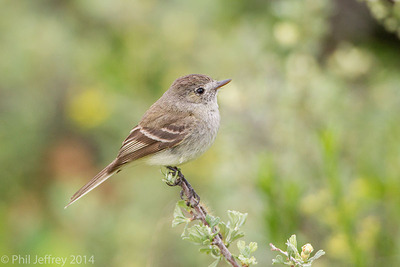
Dusky Flycatcher, Grand Teton NP
Further south along Moose-Wilson Road at the marshy area many Yellow Warblers, icterids, (House Wren) and (Western Wood-Pewee) but I did not stop and investigate, heading instead to the Valley Trail off Moose-Wilson Rd where I was pretty much the only person on-trail. I had to wade a small fast-running stream of snow melt-water but found: Chipping Sparrow, Western Tanager, Audubon's Yellow-rumped Warbler, Pine Siskin, Warbling Vireo, Ruby-crowned Kinglet, multiple Hammond's Flycatchers along the trail and in parking lot, three Gray Jays at parking lot including very distressed Ruby-crowned Kinglet, (Spotted Towhee), Black-headed Grosbeak female with a singing male, Northern Flicker, female Williamson's Flycatcher, Swainson's Thrush, Red-breasted Nuthatch feeding at nest cavity. I eventually saw Western Wood-Pewee, but (MacGillivray's Warbler) was far less cooperative. This was the same trail I tried in June 2009 for Ruffed Grouse with the same result: zero. Either I'm an optimist or slow on the uptake. An Empidonax in Hammond's territory repeated a Least-like call - likely still Hammond's although I was right on the edge of Least Flycatcher breeding range - Least just don't favor conifer habitat.
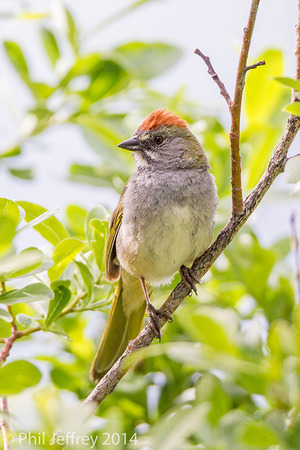
Green-tailed Towhee, Grand Teton NP
At the Lupine Meadows trailhead: heard Olive-sided Flycatcher but no visual, the now-usual alpine suspects including Western Tanager (MacGillivray's Warbler) but nothing useful climbing the trail - this proved to be a waste of time. Canada Goose at the meadow along the trail. By mid-afternoon the sleep-deprivation and the hiking led me back to Jackson for a siesta, although I did stop at the ponds behind the visitor center at Jackson to find: Cinnamon Teal, Green-winged Teal, icterids, Canada Goose. At the flats overlook just north: Mallard, Gadwall, Trumpeter Swan, a pair of Redheads, Red-tailed Hawk along the ridge, Northern Harrier over marsh. I took the unusual step of taking late afternoon into evening off on Day 2 and instead grabbed dinner in downtown Jackson where I also caught up with some Cedar Waxwings.
Year Birds: Western Tanager, Hammond's Flycatcher, Gray Jay
Overnight Snow King motel (Jackson), night 2 of 3.
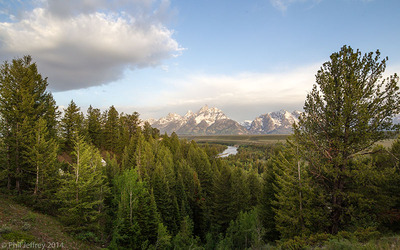
Snake River Overlook, Grand Teton National Park
While doing a little sunrise shooting at the Snake River Overlook I saw Red-breasted Nuthatch but the light was marginal with heavy cloud from the south. At the Oxbow Bend of the Snake River: American White Pelican, American Wigeon, Western Grebe, Osprey, MacGillivray's Warbler, singing Gray Catbird, distant singing Willow Flycatcher. Signal Mountain: MacGillivray's Warbler, Western Tanager, Warbling Vireo, Red-breasted Sapsucker male, 2 Hairy Woodpeckers, Brown Creeper after seeing two Dusky Grouse at the top and being assaulted by very enthusiastic mosquitos. I associate Gray Catbird with being an Eastern species, so thought this was a "better" bird than it actually is, being rather widespread in montane valleys.
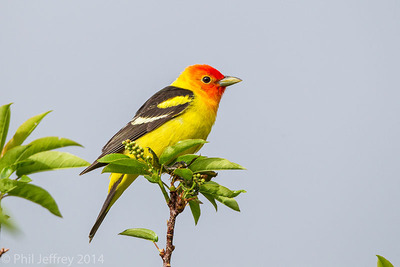
Male Western Tanager - on a generally cloudy morning it chose one of the few sunny intervals to perch up like this
I took Jenny Lake Scenic Drive for a little scenic photography and stopped at the visitor center: White-crowned Sparrow, Violet-green Sparrow, Yellow Warbler. At Lupine Meadows I finally found a singing Olive-sided Flycatcher albeit distant views, and a Calliope Hummingbird in the streamside willows with (Sora), Lincoln's Sparrow and Vesper Sparrow. One of the two raptors seen was a distant Accipiter that might have been Sharp-shinned, the other being Osprey. Took me a while to realize that the cloud over my head was really a perpetually-regenerating one, so waiting for it to get sunny for hummingbird photography was futile. Nevertheless - and despite breezy conditions - I did snag some passable male Calliope shots with the 800mm and 1.4x teleconverter combo. This is the smallest bird in North America so no lens is too long for this subject.
Down through Moose, the visitor center did not seem to have hummingbird feeders but there was a moose itself at the main road bridge drawing significant crowds. The 800mm is way too large for most moose photos so I had to walk away from it on the river bank for a decent distance. Comes in handy for other large mammals where it would be ill-advised to get too close. Moose-Wilson Road had nothing special but one additional moose causing its own little Moose-jam. The weather was getting very windy - a feature of the first few days - and I headed north to Yellowstone to check out a few sites before returning to Jackson. In Yellowstone the wind seemed to eliminate anything visible on the lake, limiting me to Spotted Sandpiper and Swallows along Gull Point Drive, distant Goldeneyes and American Wigeon at Fishing Bridge, White-crowned Sparrow and Yellow-rumped Warbler at West Thumb Geyser basin, a single Bald Eagle at a burn site adjacent to lake (no woodpeckers despite looking like a promising burn site - although perhaps the same one visited in 2009).
North into the Hayden Valley along the Yellowstone River, Common Merganers and Canada Goose, Red-tailed Hawk and the first sighting of Bison/Buffalo in Yellowstone. At several river stops I added: Cinnamon and Green-winged Teals, Spotted Sandpiper, Bufflehead, Lesser Scaup, American Wigeon, Mallard, Barrow's Goldeneye and American Whtie Pelican. As before, Hayden Valley was not very productive for mammals other than Bison.
Since one of the purposes for the afternoon's foray into Yellowstone was to "do the tourst sites" in the less birdy afternoon I took the cutoff road from Canyon to Norris and Madison to sites such as Fountain Paint Pots and Old Faithful where I gathered with many other tourists to watch that geyser erupt. Time was getting short and it erupted just in time, so I could walk briskly across the parking lot to avoid the bulk of the traffic and head south once more to Grand Teton NP. The geothermal sites at the south-west segment of Yellowstone NP are spectacular but everyone else thinks so too, and it's not a very bird-laden section of the park.
After catching Old Faithful and making it back to Grand Teton NP I focused on the Oxbow Bend area near sunset. At the flats just west of the Oxbow Bend pull-off (willow, aspen, some pine): Killdeer, Ruby-crowned Kinglet, American Robin, Yellow Warbler, Northern Rough-winged Swallow, Common Merganser, female Goldeneye sp., Mallard, American Wigeon. This habitat obviously held Ruffed Grouse if only you could find one. Parking at a pull-out near Oxbow bend I walked roadside to inquire as to the nature of the "wildlife jam" happening here - I had seen it to the west of the willow flats. I had assumed Elk or Moose but this one turned out to be my life Grizzly Bear, seen well briefly, although spending much of its time invisibly rummaging in willows. The national parks staff actively manages traffic and tourists at these wildlife jams, and they got extra cautious once they lost sight of the Grizzly which disappeared for quite a while. I headed for the nearby dam road to do sunset photography, and was alerted by a distressed mammal - a baby elk - yelping behind me. I turned around and saw it running along - yelping for a very good reason since there was a pursuing Grizzly - headed across the sagebrush flats in my direction. Still a few hundred yards away, so no reason for panic, but certainly a great deal of reason for circumspect behavior. (I heard later that the Elk escaped). Quick mental math involving me+hungry Grizzly led me to retreat to the car and the Grizzly vanished into willows again. As dusk fell I saw the bear moving from the flats, crossing the road and disappearing up the mountain. Grizzly was the mammal I particularly wanted to see on this trip, so that was quite the end to the day (no pics since it wasn't cooperative). Sunset is close to 9pm in the Tetons so I got a late 10:30pm dinner at a Jackson brew pub once I made it back to town - many other places were closed at that stage.
Year Birds: Calliope Hummingbird, Olive-sided Flycatcher
Life mammals: Grizzly Bear
Further along Moose-Wilson I heard an (Olive-sided Flycatcher) and at Sawmill Pond a Moose pair with juvenile, (Broad-tailed Hummingbird), Dusky Flycatcher, Cedar Waxwing, Swallows, 2 male Green-winged Teal. Perversely despite hearing many Broad-tailed Hummingbirds in WY I never did clap my eyes on one. At the nearby Mormon Barn where I did a little scenic photography: Bison, Western Meadowlark, Black-billed Magpie, Northern Harrier. Heading north and out of Grand Teton for the last time I found nothing of significance at Oxbow bend or at Coulter Bay but at the lake overlook at least I had Western Grebe and American White Pelican. Now, on to Yellowstone for the bulk of the next two days.
At Yellowstone NP the cloud cover was quite extensive with a few sunny patches. West Thumb basin: White-crowned Sparrow, 2 Barrow's Goldeneye. A stop at LeHardy Rapids: 1 female and 4 male Harlequin Ducks in the rapids. At Hayden Valley: same as the previous day for the most part, but two Wolves (a first for the Lower 48 for me) one white, one dark, seen at great distance through my spotting scope and barely recognizable as such. At Canyon: nothing of note apart from views of the falls and with the early summer snow melt in full bore the Yellowstone River was putting a lot of water over them. At Mt Washburn: Elk, Buffalo in the grassy valleys on the northern side. At Tower Junction I looped west to Floating Island Lake: American Coot, Ruddy Duck, Yellow-headed Blackbird, but missed the bear causing the bear jam on way back west towards Lamar Valley.
I was luckier near the western end of the Lamar Valley with a Black Bear working its way slowly along a nearby hillside (good scope views), Bison with young, Red-tailed Hawk, then Lesser Scaup/Ruddy Duck/Coot in roadside ponds. At Slough Creek: American Wigeon, American Coot in the small ponds, nothing on the river, various swallows, Pronghorn and then a female Black Bear (with hidden cubs) resting underneath some evergreen trees. Slough Creek is pretty much the western end of the Lamar Valley. In the Lamar Valley itself: many Buffalo, few to no Elk, a few Pronghorn, no notable birds. I was headed out of the north-east entrance towards the Beartooth Highway and Montana, but saw a pale Red Fox before the MT border and a Moose after the road cuts back into WY. No hummingbird feeders were seen in Cooke City or Silver Gate, so I just gunned it to the alpine region along Beartooth Highway. Up around Top of the World I found American Pipit in much the same area as in 2009, then Black Rosy-Finch, more American Pipit, Horned Lark further up in the alpine at both passes with White-crowned Sparrow flocking with the finches on WY side. A Florida couple stopped to ask for the nearest gas station (I pointed them to Red Lodge MT, the nearest town, hope they made it) and they expressed disbelief that this road was an unadvertised and just outside a national park. Beartooth, and Chief Joseph highway, are particularly scenic drives and yet probably go overlooked by many who visit the Yellowstone/Grand Teton area. It's a bit of a round trip, and thankfully this makes for light traffic for those of us who do know this area. My overnight destination was the Sunrise Inn in Cody (cheaper than average and entirely fine for one night) and that was still a fair way away so I made good time in the 65 mph speed limit along the spectacular Chief Joseph scenic highway, pausing to gawk at Moose, before spiralling up over the pass and eventually down into Cody for a single night. Cody was co-founded by Buffalo Bill, which forms the basis for much of their tourist attraction. That and being the eastern approach to Yellowstone.
Year birds: Black Rosy-Finch
From the WY/SR-296/US-212 intersection I checked various Alder patches for Ruffed Grouse (no) and found: House Wren, Hammond's/Dusky Flycatcher, Green-tailed Towhee, Warbling Vireo, American Robin, two male Cassin's Finches, Dark-eyed Junco, Clark's Nutcracker, Pine Siskin, and distant bugling (Sandhill Crane ? Elk?). At 9am there was still 90% cloud cover at the east side of Yellowstone, so no incentive to head up Beartooth Pass. There was very obviously nothing of note in the Montana section of Beartooth heading towards Yellowstone. Once I got into the Yellowstone National Park I stopped at the Mountain Goat site and took too long to find a small herd of them on the steep rock face. A little further along was a brown morph Black Bear, feeding roadside, an American Dipper at one of the Soda Creek river crossings, and then an increasing number of Buffalo as I entered the Lamar Valley. Cliff Swallows were nesting at Soda Butte but the Bison were prominent there - grabbing the big telephoto rig from the car would invite some close personal encounters with these Bison, most or all of whom were males. The group included one assertive bull who decided to demonstrate that he in fact owned the territory around Soda Butte, huffing and stomping at the dirt viewed from the safety of the car.
Aside from the fine Bison displays, few birding moments. An Osprey nest along the narrow section of the Lamar River, a Bald Eagle at Slough Creek, but no bears. Along the Slough Creek Trail an Empidonax flycatcher (Hammond's/Dusky) sitting on a branch minding its own business was confronted by a male Calliope with a full flare of the gorget. Lincoln's Sparrow, Warbling Vireo, Ruby-crowned Kinglet, Olive-sided Flycatcher, Pine Siskin, with Green-tailed Towhee in the adjacent sagebrush. I decided to skip the Tower Falls potential circus of mother bear + cubs and went west to Blacktail Ponds: Cinnamon Teal, 2 Ring-necked Ducks - this was relatively open country but hosted only a small number of mammals. Mammals were very much in evidence at Mammoth, however: it was a plague of Homo sapiens in the form of the Tourist who were grabbing lunch and generally swarming the attractions. I skipped most of the geothermal features on grounds of sanity but did do the short Upper Terrace drive which had a lot fewer tourists than the lower terrace features.
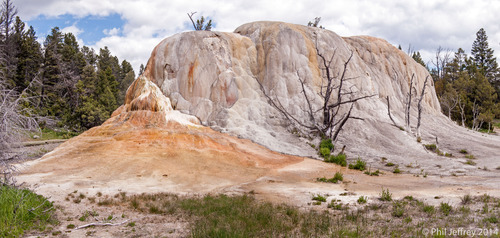
Orange Spring Mound, Mammoth Hot Springs, Yellowstone National Park
One of the notable things about these thermally-originated formations is how the (presumably thermophilic) bacteria have stained the rock various colors, in the above case Orange Spring Mound gets its color from these cyanobacteria. South to Madison Junction via Norris held nothing of note so I turned west to West Yellowstone and exited the National Park. Again, nothing added to MT list in this stretch through West Yellowstone, but RVs were still getting in my way along US-20 as I entered Idaho. To avoid them I went to the west side of Henry's Lake - the headwaters of the west fork of the Snake River, using it initially as an approach to the road leading to Red Rock Lakes NWR (MT).

Adult Tree Swallow, Henry's Lake, Idaho
I started finding quite a few good Idaho birds in this area: Black-billed Magpie, Mountain Bluebird and Tree Swallow in the numerous road-side nestboxes, Ring-necked Duck, Double-crested Cormorant, Savannah Sparrow. The dirt road leading to Red Rock Lakes NWR - which was designed to be my major afternoon venue - was not very good and it was clear that the 22 miles each way to/from the refuge was going to take an eternity. It's a viable day trip but not a quick afternoon's jaunt. I reluctantly abandoned the Red Rocks detour and turned around at a willow-lined creek that was quite productive: Brewer's Sparrow in the sage, Cassin's Finch, Pine Siskin, Western Tanager, (Yellow Warbler) and returning along Henry's Lake: Vesper Sparrow, Franklin's, California and Ring-billed Gulls, Caspian Tern, Western Wood-Pewee, Eastern Kingbird, many Double-crested Cormorants, ALL the swallows including Cliff and Bank, American White Pelican, Bufflehead, Gadwall, (House Wren), (Sora), more Savannah and Brewer's Sparrows, Red-winged Blackbird, Brewer's Blackbird, Mallard and perhaps the biggest surprise - Red-necked Grebe. That was a pretty big haul for one side of a lake in a state I'd spent less than an hour in. In fact I spent the rest of the day in Idaho.
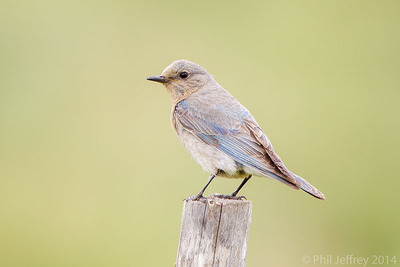
Adult female Mountain Bluebird, Henry's Lake, Idaho
Returning to US-20 I missed the Swan Lake stop I intended for potential Trumpeter Swan, and at the couple of stops I did make nothing new was added (California and Ring-billed Gulls, Caspian Tern over Henry's Fork of the Snake River). The one stop I did make that was particularly rewarding was Market Lake WMA north of Roberts, adjacent to I-15 and north of Idaho Falls. One piece of signage indicated that it was an Important Bird Area and the number of species I turned up indicated why: American Kestrel, several White-faced Ibis, Rock Pigeon, Mourning Dove in the road from US-20 to Roberts via Menan; House Sparrows, Eastern Collared-Dove in Roberts itself then an expanding list of water birds as I headed north on country roads: Yellow-headed Blackbird, Red-winged Blackbird, more White-faced Ibis, Snowy Egret, Great Blue Heron, Black-crowned Night Heron, Canada Goose, Ring-necked Duck, Cinnamon Teal, Mallard, Ruddy Duck, Redhead, Gadwall, Wigeon, Lesser Scaup, American Coot, American White Pelican, Wilson Phalarope, Killdeer, Common Nighthawks, 2 Short-eared Owls over marsh, Northern Harrier, Eared Grebe, Western Grebe with young, Franklin's and California Gulls, Forster's and Caspian Terns, (Song Sparrow), (Common Yellowthroat). I found that I could not emerge from the north end of the WMA onto the interstate but had to double back through Roberts, which is not the most affluent little town that I've ever encountered. I added a pair of Red-tailed Hawks on the backtrack one of which was banded.
What turned out to be the final stop of the day was Camas NWR which is a breeding location for Trumpeter Swan (perhaps). I found about half the ponds to be dry, including ones that had interpretive signs in front of them, and the NWR website indicates "The water supply at Camas has decreased over the years due to natural drought cycles and agricultural development, which have lowered the water table." I did not see any Trumpeters on the auto route but snagged most of the same waterfowl as at Market Lake WMA. I also saw two Sandhill Cranes and a couple of Swainson's Hawks. At the parking area where stopped to figure out the night's destination I saw an Oriole sp. which given that it was in streamside cottonwoods was almost certainly Bullock's - it did not cooperate for an ID.
Since I was still quite a way from Utah I decided to break the southbound trip via a motel in Pocatello ID. This didn't seem to be a stop one would otherwise find notable but was a useful staging area for the night. Once again I found the Kayak app to be pretty useful for finding cheaper hotels on the fly but sometimes the booking interface is flaky.
Year list birds: Bank Swallow, California Gull, Wilson's Phalarope
Then down to the Great Salt Lake at Bear River NWR - the road seems paved for more miles now than in 2007 with more interpretive signs in progress. Cinnamon Teal were common, Mallard, Gadwall, and a few Long-billed Curlew along the approach road. The Curlews had several juveniles - smaller with shorter less curved bills they had me wondering what I was seeing for a while since they were also colored richer colors that were somewhat evocative of Hudsonian Godwit. On the auto tour around the impoundments, Clark's and Western Grebes, Killdeer, Caspian and Forster's Tern, American Avocet and Black-necked Stilt and a few Wilson's Phalarope, Northern Harrier, Savannah Sparrow, American Coot, Ruddy Duck, Canada Goose, Double-crested Cormorant Western and Eastern Kingbirds, swallows (Barn, Cliff), White-faced Ibis, Great Blue Heron, California and Franklin's Gull, American White Pelican, Turkey Vulture, Marsh Wren, Red-winged and Yellow-headed Blackbirds and a bird that had escaped me so far: a female Great-tailed Grackle. The Wilson's Phalaropes and Black-necked Stilts were nesting in a marshy area next to the wildife drive.
South then to Antelope Island State Park, my last stop in Utah: $10 fee and most of the action was along the causeway: California Gull, Willet, American Avocet, Wilson's Phalarope. A big flock of Eared Grebe bobbed near one of the gaps in the causeway, and a single Long-billed Curlew flew over. On the island I saw a Common Raven family (were previously nesting at the visitor center), Loggerhead Shrike, Western Meadowlark along with a handful of Bison. I missed the Chukar that are often found near the visitor center but it was hard to miss the large numbers of Barn Swallows nesting under the eaves. Brine flies were abundant on the lake and were well-represented on the front of the car after two passes over the causeway.
After rinsing off the rental car and repacking I flew Southwest Airlines to Denver which departed about 20 minutes late (this is within the envelope for a summer afternoon, IMHO) and got to Denver more-or-less on time. Enterprise car rental was speedy and very friendly - this is the outfit I used in April - and I managed to get out of the airport in a Hyundai Tucson before sunset. Car rental prices are a lot higher in Denver than in Salt Lake City. The rapid exit allowed me to find Burrowing Owl at the same site that I tried for them in April - this time I had more luck seeing one owl along with Western Meadowlark, Cliff Swallow, American Kestrel.
Overnight in some mediocre Motel 6 in northern Denver. I ended up staying in Motel 6's more on the Colorado leg because it was a bit harder to find reasonably-priced hotels in Colorado. [update 2018: Motel 6 disclaimer: I had largely stopped usingthis chain because of their high average ineptitude, but the final straw is their overt racism]
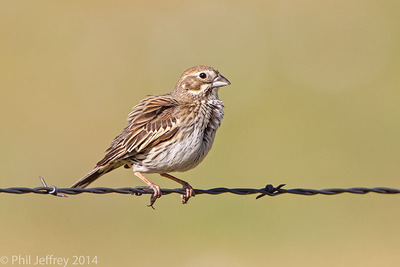
Lark Bunting juvenile, Pawnee National Grassland
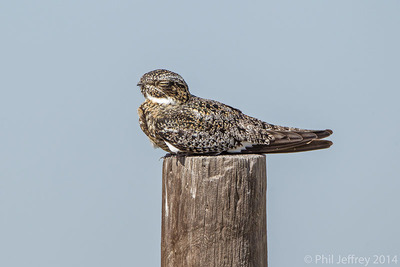
Male Common Nighthawk, Pawnee National Grassland
I moved on to CR-110 on in an unsuccessful quest for Mountain Plover but saw Loggerhead Shrike, Common Grackle, more Lark Buntings/Meadowlarks. Coming back down CR-77 I fell afoul of the local oil/gas truck traffic debris and picked up a flat tire that took much of the next few hours to fix - first changing to the emergency spare then getting the flat itself fixed in Granby, since there aren't any locations that close to the grasslands.
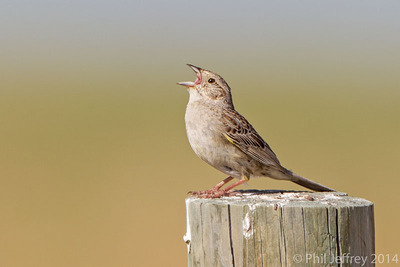
Singing Cassin's Sparrow, Pawnee National Grassland
As the flat repair cost me some time I jettisoned a few optional sites like Reynold's Park and instead went up to Rocky Mountain National Park to check out the alpine sites. RMNP is interesting and often picturesque but lacks the impact of Grand Teton or the sheer scale of Yellowstone. The road up to Estes Park from Loveland has been mostly repaired after the floods of 2013, but there was still some construction activity which had just ceased by the time I passed through. Since it was mid-afternoon I ignored lowland sites and went up to Lava Cliffs (no Rosy-Finches but Marmots and Elk), Rainbow Curve (no Ptarmigan but White-crowned Sparrow, American Pipits in full alternate, Horned Lark), and the Alpine Visitor Center where a fleeting look at a fly-by chunky dark passerine was probably a Brown-capped Rosy-Finch which did not show itself again. I'd seen them very well indeed in CO in April so this was just a trip list miss.
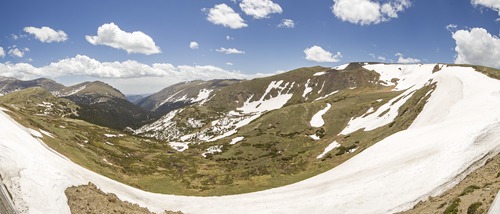
Trail Ridge Drive panorama, Rocky Mountain National Park
Overnight at yet another Motel 6, this one in Fort Collins. Given the drive up/down canyon to Estes Park I should probably have snagged an overnight motel there (I saw one advertised for $80-ish the following day but I'd assumed they'd be far more expensive).
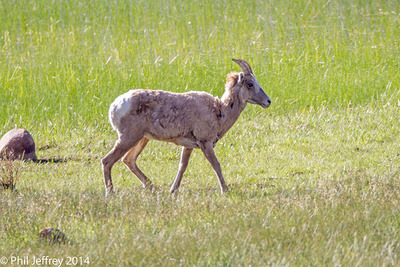
Bighorn Sheep, Endovalley, Rocky Mountain National Park
Starting in the lowlands of Rocky Mountain NP in the morning, Elk and Bighorn Sheep were in Horseshoe Meadow, West Horseshoe Park had House Wren, Ruby-crowned Kinglet, Audubon's Yellow-rumped Warbler, Lincoln's Sparrow, (Song Sparrow), American Crow, weakly singing (Hammonds'-ish Flycatcher) and more cooperative Dusky Flycatcher in the willows, (Wilson's Warbler), Warbling Vireo, fly-over and drumming Red-naped Sapsucker, Broad-tailed Hummingbird, Violet-green Swallow, Mountain Chickadee. Endovalley Road was closed at the alluvial fan site - likely because of flood damage - but here I saw Wilson's Warbler, Yellow-rumped Warbler, Broad-tailed Hummingbird, two Black-billed Magpies trying their best to make a squirrel their breakfast. At Upper Beaver Meadows another Red-naped Sapsucker showed up alongside the car, Dusky Flycatcher at the parking lot, Northern Flicker, Olive-sided and Cordilleran Flycatcher little up further up the trail. Cordillerans had been especially hard to find in Grand Teton (where there are a few eBird reports) but in Colorado they turned out to be much more numerous and Hammond's rather more scarce - this seems to be borne out by the density of eBird reports for the respective species and it's not just my dilettante attitude when it comes to agonizing over cryptic Empidonax flycatchers (although that's a factor too).
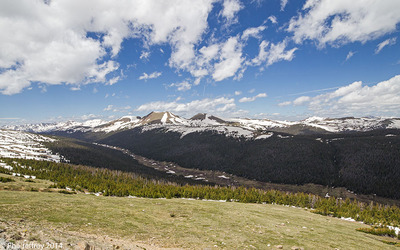
Trail Ridge Drive, Rocky Mountain National Park (view from Medicine Bow curve, looking down the valley to the south)
Up at Trail Ridge Drive: American Pipit and Horned Lark at a windy Medicine Bow, Violet-green Swallow at Alpine visitor center, Clark's Nutcracker at Lake Irene along with Common Raven, Western Wood-Pewee, House Wren, (White-breasted Nuthatch). I traversed back across the alpine area to another part of RMNP called Wild Basin down near Allenspark that had reported Three-toed Woodpeckers but saw none. Instead American Robins, Western Tanager, Broad-tailed Hummingbird, Audubon's Yellow-rumped Warbler. Faced with a potential 2 hour schlep just to get to Reynolds Park I went back over Trail Ridge Drive and down toward Granby, a drive that added few new birds except my first Colorado Ospreys for the trip over Lake Granby and a Swainson's Hawk outside Granby. Turning north from Granby toward North Park via SR-125 I noticed the spruce/pine forests with extensive insect damage - the majority of the trees killed (apparently by the Pine Beetle) over a massive area. A recent NY Times article on global warming raises the possibility that this event, along with several other forest die-offs, could be related to the elimination of super-cold winters that killed that beetle off. You would think Three-toed Woodpeckers would be truly abundant given the magnitude of this insect kill but with so many options they may be widely dispersed. After a couple of mountain passes I made it into North Park where there were a few icterids (Brewer's) but nothing like I'd seen in comparable valleys in Utah or Wyoming. More Swainson's Hawks, a Golden Eagle, and various anonymous sparrows perched on the fences (I'm guessing mostly Vesper).
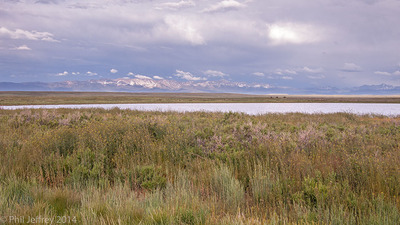
Arapaho National Wildlife Refuge, looking east towards the Rockies and RMNP
A novelty was finding the Arapaho NWR wildlife drive open (it's closed in April) and is perhaps 5 miles of well-graded dirt road so not too time-consuming. Brewer's, Yellow-headed and Red-winged Blackbirds in marsh, Brown-headed Cowbird, a few Sage Thrasher, Brewer's, Vesper and several Savannah Sparrows. Some Brewer's had particularly atypical songs. Many Cliff Swallows. Eared Grebes, Canada Goose, Mallard, Gadwall, 1 Northern Shoveler, Redhead, Coot, Green-winged Teal (2), American Wigeon, several Wilson's Phalaropes, American Avocet, two Pied-billed Grebes including one vocalizing. Western Meadowlark, Common Nighthawk, Killdeer, Horned Lark, 2 Willet. A fairly reasonable haul and a mix of waterbirds and sagebrush species.
North a short distance to Walden which is apparently the Moose Viewing capital of Colorado. Who knew ? Although the nearby State Forest visitor center does have a large moose sculpture right out front. When I was here in April the ponds were mostly or totally frozen, but now everything was thawed and warm. The small pond near the reservoir (aka Lake John) had Gadwall and Clark's Grebe with hunting Forster's Tern. There is apparently a small pocket of breeding Forster's Terns in this area, shown on the range map in Sibley. On Lake John/reservoir: Western and several Eared Grebes, California Gull with chicks, Forster's Terns, Double-crested Cormorants with chicks, American White Pelican, American Coot, one Wilson's Phalarope, Canvasback, Belted Kingfisher on the wire over the Illinois River, Snowy Egret nearby, Black-crowned Night Heron, Blue-winged Teal, truly abundant Tree Swallows, Yellow-headed Blackbird.
The overnight destination was the Steamboat Hotel - third time there and reliably the cheapest non-fleabag hotel in the Steamboat Springs area. Cheaper options are to be had in Craig, but Craig-Steamboat is ~40 miles so much of the economic benefit negated by an 80 mile round trip. Even in Steamboat several restaurants shut kind of early - this is probably off-season for Steamboat - but I snagged Mexican at a newish restaurant along the main drag.
New for year: Cordilleran Flycatcher
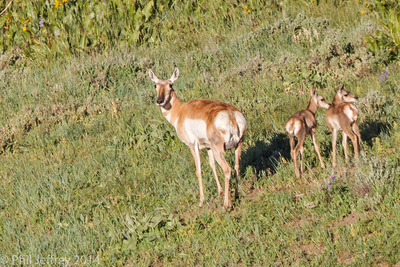
Pronghorn with young, 80 Route, Hayden
Thursday morning saw me chugging north along 80 Route north of Hayden at 6:15am with American Kestrel and Western Meadowlark along the first section of the bluffs, Blue-gray Gnatcatcher in the oak woodland on the south slope of the bluff with House Wren. 80 Route is a perennial favorite of mine but probably unremarkable compared to similar back roads nearby. Once away from the Yampa valley, female Mallards with ducklings were at the first two ponds. Western Meadowlark and Vesper Sparrow were numerous in the sagebrush, with a few (Brewers Sparrow). Icterids were mainly Brewer's, a few Red-winged Blackbirds, (Yellow-headed Blackbird). I encountered two families of Mountain Bluebirds and a male American Goldfinch. The larger ponds held Lesser Scaup, Gadwall, American Wigeon, Ring-necked Duck, Spotted Sandpiper, Eared Grebe and at the largest pond a heard (Willow Flycatcher) and a Song Sparrow. The road climbed then dipped into a cottonwood-lined riparian area that held House Wren, Flicker, Yellow Warbler, (Warbling Vireo) and then climbed once more into the aspens. At the edge of the aspens: Dusky Flycatcher and Hairy Woodpecker, (Western Wood-Pewee), while further in: Dark-eyed Junco, Western Wood-Pewee, Warbling Vireo, Lincoln's Sparrow, Audubon's Yellow-rumped Warbler, a flycatcher giving a Least-ish call that wasn't quite emphatic enough to be certain but was in deciduous-Aspen habitat.
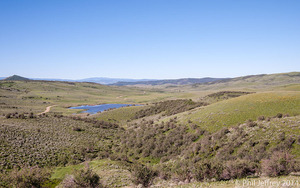
|
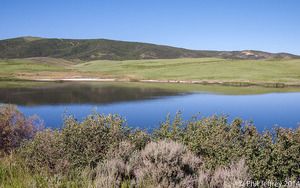
|
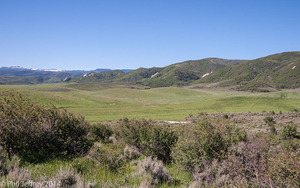
|
| Three views along 80 Route, Hayden, CO | ||
This is about as far up I went in 2006 and the woodland here is an aspen monoculture since it's still too low altitude for spruce or pine. Small patches of spruce could be seen on the sheltered (colder) slopes. Some people actually had log houses up here, despite I assume some inaccessibility in winter - this whole route is a mix of state and private land. On the first few miles of the return trip a Cooper's Hawk (mobbed by Brewer's and Crow) and Swainson's Hawks, Barn and Tree Swallow.
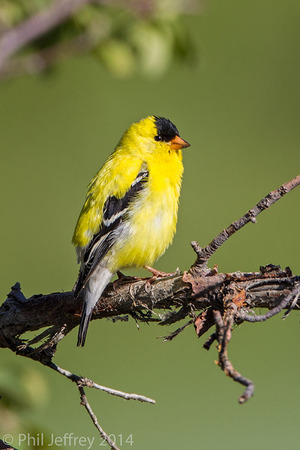
|
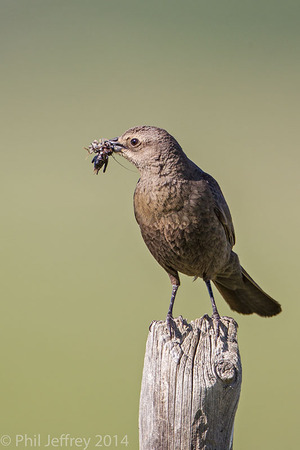
|
| Male American Goldfinch | Female Brewer's Blackbird with food |
A brief check of 20 mile Rd/20 Route/CR-27 at the pond near the lek: Canada Goose, Pied-billed Grebe, Cinnamon Teal, Coot, Elk and Pronghorn at the other side of the pond, (Common Yellowthroat) but there were no notable land birds at the second lek site (old highway). I was not expecting to see grouse here. I returned to Steamboat Springs to check out of the hotel, then made a back roads route along a dusty and rutted CR-45 that went through a riparian corridor: House Wren, White-crowned Sparrow, Western Wood-Pewee, Green-tailed Towhee, Mountain Bluebird, Vesper Sparrow, Broad-tailed Hummingbird. After lunch in Steamboat I made the long slog towards Grand Junction via Craig, Meeker and Rifle. SR-13 towards Meeker nothing much, just a few icterids, Canada Geese at the reservoir on the Craig side of the pass, Gadwall at the pond at the pass itself, Golden Eagle hunting in the sagebrush valley nearer Meeker. Some Brewer's Blackbirds and Black-billed Magpies along route to Rifle but generally pretty birdless with no hot spots.
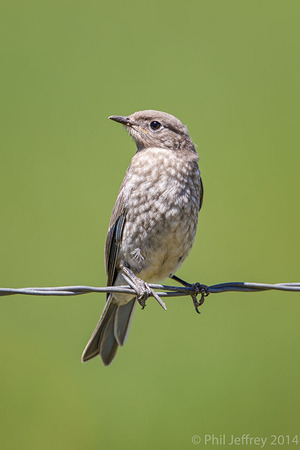
|
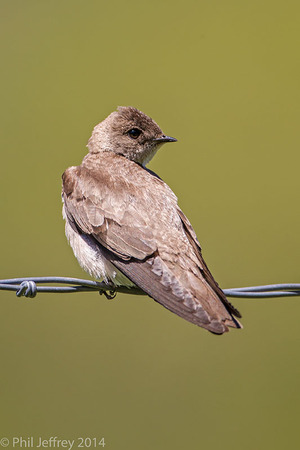
|
|
Mountain Bluebird, Steamboat Springs | Northern Rough-winged Swallow |
Chancing my luck at the same afternoon visit to Coal Canyon/Cameo that I did in April: Western Kingbirds along lower valley, initially very quiet at the parking lot, then more Western Kingbirds, singing Gray Vireo (which caused confusion with Western Kingbird since line of sight for the vireo went right through a perched Kingbird), Black-throated Sparrows, Blue-gray Gnatcatcher, Rock Wren seen flying across valley and perched up just close enough to ID. I spent a little time making sure of the Gnatcatcher ID since it seemed pretty dry terrain but both adults were in alternate plumage, the male had the thin black supercilium mark, and by the undertail the only other thing they might have been was Black-capped. Not only is the habitat wrong for Black-capped - they prefer "riparian" canyons with dense vegetation in Arizonan mountains, but that species is unknown in Colorado. The Gnatcatchers were also pretty assertive since I think I was fairly near the nest in a nearby juniper. Two Bullock's Orioles were seen nesting in a cottonwood next to the canal near the interstate.
Overnight at another glorious Motel 6 - these are no longer my hotel of choice but both car rental and hotel prices were fairly high in Colorado so I tended to economize at the bottom end hotel chains. Certainly this particular Motel 6, despite ongoing "renovations", was nothing to talk about. (My favorite location from April, the EconoLodge, was sold out).
New for year: Gray Vireo
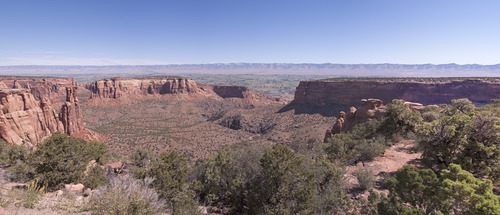
Rim Rock Drive, Colorado National Monument
Further up the mesa I stopped at the top of Serpents trail and had Ash-throated Flycatcher, House Finch and (Canyon Wren). Apparently this foot trail is the remnant of the original road up the Monument where cars had to reverse up through all the switchbacks - lack of fuel pumps would not let them drive forwards up that sort of hill. White-throated Swifts were at the mesa top from the overlook(s) along with a couple of Violet-green Swallows, Common Raven. At McGinnis hunter access from Glade Park road: Virginia's Warbler, (Western Tanager), Spotted Towhee, (Plumbeous Vireos), Chipping Sparrow, Olive-sided Flycatcher, Lark Sparrow, Northern Flicker. Rock Wren heard and subsequently seen along the overlooks and a Western Scrub-Jay popped across the road. No Pinyon Jays on this visit, unlike in April. At the visitor center I found a vocal Juniper Titmouse on a short hike toward the campsites and then I returned to Glade Park Road where Mountain Biuebirds, Vesper Sparrow, Sage Thrasher were all seen along the paved road but I missed out on the desired Western Bluebird.
I exited the eastern end of the monument, driving down through Montrose (lunch) to Ouray where my only significant target for the rest of the day was Box Cañon/Canyon Falls. I actually saw two Black Swift in flight over the parking lot - that was a first for me and particularly satisfying - and eventually found one perched on the nest. Violet-green Swallows were also overhead and a Cordilleran Flycatcher in the canyon at the mouth of the falls. Broad-tailed Hummingbird was heard but not seen but that was the extent of the birds at this site - the feeders were more active in July 2007 when I was last here. I followed US-550 south over two passes but (Hermit Thrush), (Warbling Vireo) were the more interesting birds and there wasn't much to prevent me starting the trek toward the Front Range. The Black Swifts were certainly worth the detour but Ouray did put me a long way away from the Denver area in the mid-afternoon.
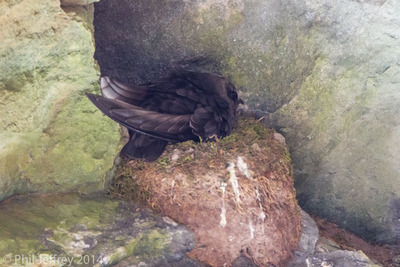
Black Swift on nest, Box Canyon Falls, Ouray
Two competing plans: Conifer and Reynolds park up in the Front Range foothills; Winter Park for an overnight before another assault on the alpine at Rocky Mountain NP. The Winter Park/RMNP plan won when it became obvious that I could not reach the Front Range before sunset, although I did not settle on this plan until Salida (i.e. east of Gunnison). Google suggests Ouray-Winter Park is slightly faster via I-70 than via the route I did take via Gunnison/Salida/Monte Vista, but the difference is 15 minutes in nearly 6 hours. Which is about the time it did take, more or less. En route not much was seen except I had two Lewis's Woodpeckers - one at road construction between Cimarron and Gunnison (west of the start of the large lakes in Curecanti NRA), and one along US-285 north of Salida. Apart from a refuel/refresh stop in Gunnison I made birding stops at the Monarch ski site pulloff (no woodpeckers) just east of Monarch Pass along US-50 and also at the crest of the pass itself (Continental Divide, 11,320 feet) where a short walk up the trail yielded Pine Siskin, Red Crossbill (1), Ruby-crowned Kinglet, Yellow-rumped Warbler and a major moth hatch-out along the entire montane pine area. In terms of altitude the high point of Rim Rock Drive in Colorado NM is only 6,640 feet so Monarch pass was 5,000 ft higher - you can see why they call it the "western slope" of Colorado, since it is so much lower than the montane and not all that much higher than Denver (5,520 ft) in the high plains. [Wikipedia defines the Western Slope as being "west of the Continental Divide" but most people would not place Steamboat Springs on the western slope]. American Kestrel and Black-billed Magpie don't really make much of a highlight reel as I trekked through Monte Vista and Leadville along US-24 up the headwaters of the Arkansas River for quite a while, and then down SR-91 until reaching the interstate. Monarch Pass is one of the Continental Divide crossings, and the Arkansas River is one of the major tributaries of the Mississippi, as if to emphasize that. Just beyond Leadville a large mining facility was lit up in an almost attractive manner by the last of the day's light, but the night-time drive along I-70 was a little hairy at times. I-70 is sort of like NYC's Belt Parkway - bumpy and twisty, except that it's even worse-marked than the Belt and badly lit, so driving down it at night at the posted speed limit was quite an adventure. Climbing one last pass along US-40 got me into Winter Park just shy of 10pm where it looked like the town had mostly shut down for the night. Fortunately the hotel check-in was still open.
Overnight Winter Park, CO, just short of Granby
Year birds: Black Swift
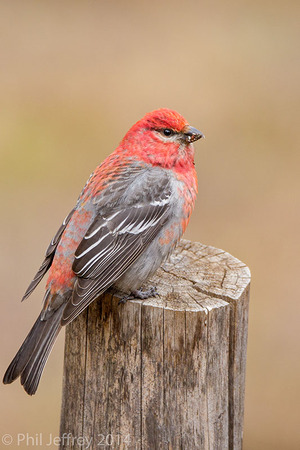
Male Pine Grosbeak, Rocky Mountain National Park
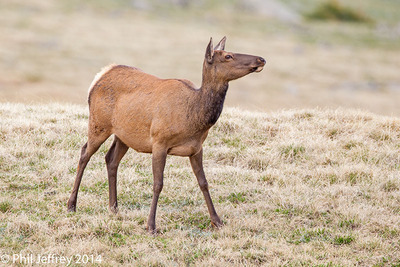
Elk feeding on alpine tundra, Rocky Mountain National Park
At Reynolds park I went looking for Three-toed Woodpecker without success. Instead Dusky, Cordilleran and (Hammond's) Flycatchers, obliging singing male Virginia's and Yellow-rumped Warblers, Warbling Vireo, Ruby-crowned Kinglet, Dark-eyed Junco, American Crow and Common Raven, immature male Cooper's Hawk. The only woodpecker seen was a male Red-naped Sapsucker bringing food to a nest hole, although I did hear a distant machine-gun drumming of (Hairy/Downy Woodpecker). With storms in the plains and a general lack of enthusiasm for battling Saturday traffic around metro Denver to add one or two birds to the trip list, I effectively ended the trip mid-afternoon and bummed around washing dirt off the car, grabbing dinner, checking out a dark and seemingly doomed bar I'd seen on Bar Rescue, and checking in for my 11:59pm red-eye flight 3 hours early. Jet Blue were at least on time for this DEN-JFK flight although I've seen a more enthusiastic set of flight attendants in my time - nothing to reverse my decision to put them in the middle/bottom of the airline pack for future trip considerations.